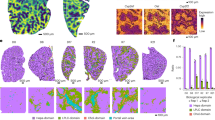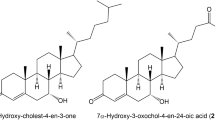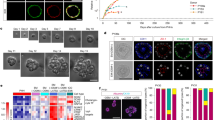Abstract
Hydrophobic bile acids are implicated in the pathogenesis of cholestatic liver disorders through mechanisms involving oxidative stress and mitochondrial dysfunction. Antioxidants ameliorate bile acid–induced cytotoxicity in rat hepatocyte suspensions. The purpose of the current study was to evaluate the potential protective role of β-carotene (βC), a putative fat-soluble antioxidant that is reduced in patients with cholestasis, against bile acid–induced hepatotoxicity. In freshly isolated rat hepatocyte suspensions that were exposed to the toxic hydrophobic bile acid glycochenodeoxycholic acid (100 or 500 μM), βC (100 μM) decreased generation of reactive oxygen species by >50%, similar to the inhibition afforded by β-tocopherol. Commensurate with this antioxidant effect, 100 μM βC also protected hepatocytes against both glycochenodeoxycholic acid–induced cellular necrosis and apoptosis, which was associated with reduction in caspase 3 activation, inhibition of mitochondrial cytochrome c release in rat hepatocytes, and prevention of the mitochondrial permeability transition in both liver mitochondria and rat hepatocytes. A lower concentration of βC (50 μM) produced similar antioxidant and anti-apoptotic protection but with less inhibition against cell necrosis, suggesting that the higher concentration of βC may have conferred additional cytoprotection not directly related to its antioxidant function. These results demonstrate that the antioxidant effects of βC may provide hepatoprotection against cholestatic liver injury by preventing bile acid–induced oxidative stress and mitochondrial perturbations.
Similar content being viewed by others
Log in or create a free account to read this content
Gain free access to this article, as well as selected content from this journal and more on nature.com
or
Abbreviations
- α-TH:
-
α-tocopherol
- βC:
-
β-carotene
- CLD:
-
cholestatic liver disorders
- DCF-DA:
-
dichlorofluorescin diacetate
- DCFein:
-
2′7′-dichlorofluorescein
- GCDC:
-
glycochenodeoxycholic acid
- KRH:
-
Krebs Ringers HEPES
- MPT:
-
mitochondrial permeability transition
- PI:
-
propidium iodide
- ROS:
-
reactive oxygen species
- Δψ:
-
mitochondrial electrochemical gradient
References
Frei B 1994 Natural Antioxidants in Human Health and Disease. Academic Press, San Diego
Sies H 1997 Antioxidants in Disease Mechanisms and Therapy, Vol 38, Advances in Pharmacology. Academic Press, San Diego
Gopalakrishna R, Gundimeda U 2002 Antioxidant regulation of protein kinase C in cancer prevention. J Nutr 132: 3819S–3823S.
Toivanen JL 1987 Effects of selenium, vitamin E and vitamin C on human prostacyclin and thromboxane synthesis in vitro. Prostaglandins Leukot Med 26: 265–280.
Olson JA 1999 Carotenoids. In: Shils ME, Olson JA, Shike M, Ross AC (eds) Modern Nutrition in Health and Disease, 9th Ed. Williams & Wilkins, Baltimore, 525–542.
Burton GW, Ingold KU 1984 β-Carotene: an unusual type of lipid antioxidant. Science 224: 569–573.
Alpha-Tocopherol, β-Carotene Cancer Prevention Study Group 1994 The effect of vitamin E and beta carotene on the incidence of lung cancer and other cancers in male smokers. N Engl J Med 330: 1029–1035
Kritharides L, Stocker R 2002 The use of antioxidant supplements in coronary heart disease. Atherosclerosis 164: 211–219.
Dietary reference intakes for vitamin C, vitamin E selenium, and carotenoids A Report of the Panel on Dietary Antioxidants and Related Compounds, Subcommittees on Upper Reference Levels of Nutrients and of Interpretation and Use of Dietary Reference Intakes 2000 Food and Nutrition Board, Institute of Medicine, National Academy Press Washington, DC
Leo MA, Ahmed S, Aleynik SI, Siegel JH, Kasmin F, Lieber CS 1995 Carotenoids and tocopherols in various hepatobiliary conditions. J Hepatol 23: 550–556.
Phillips JR, Angulo P, Petterson T, Lindor KD 2001 Fat-soluble vitamin levels in patients with primary biliary cirrhosis. Am J Gastroenterol 96: 2745–2750.
Floreani A, Baragiotta A, Martines D, Naccarato R, Dodorico A 2000 Plasma antioxidant levels in chronic cholestatic liver diseases. Aliment Pharmacol Ther 14: 353–358.
Sokol RJ, Devereaux MW, Gumpricht E 2001 Inhibition of bile acid-induced mitochondrial permeability transition by dietary antioxidants. Hepatology 34: 277A( abstr)
Watson JP, Jones DE, James OF, Cann PA, Branble MG 1999 Case report: oral antioxidant therapy for the treatment of primary biliary cirrhosis: a pilot study. J Gastroenterol Hepatol 14: 1034–1040.
Starzl TE, Demetros AJ, Van Thiel D 1989 Liver transplantation (1). N Engl J Med 321: 1014–1022.
Bove KE, Daugherty CC, Tyson W, Mireau G, Heubi JE, Balistreri WF, Setchell KD 2000 Bile acid synthetic defects and liver disease. Pediatr Dev Pathol 3: 1–16.
Sokol RJ, Winklhofer-Roob BM, Devereaux MW, McKim JM 1995 Generation of hydroperoxides in isolated rat hepatocytes and hepatic mitochondria exposed to hydrophobic bile acids. Gastroenterology 109: 1249–1256.
Sokol RJ, McKim JM, Goff MC, Ruyle SZ, Devereaux MW, Han D, Packer L, Everson G 1998 Vitamin E reduces oxidant injury to mitochondria and the hepatotoxicity of taurochenodeoxycholic acid in the rat. Gastroenterology 114: 164–174.
Rodrigues CM, Fan G, Ma X, Kren BT, Steer CJ 1998 A novel role for ursodeoxycholic acid in inhibiting apoptosis by modulating mitochondrial membrane perturbation. J Clin Invest 101: 2790–2799.
Patel T, Bronk SF, Gores GJ 1994 Increases of intracellular magnesium promote glycodeoxycholate-induced apoptosis in rat hepatocytes. J Clin Invest 94: 2183–2192.
Gumpricht E, Devereaux MW, Dahl RH, Sokol RJ 2000 Glutathione status of isolated rat hepatocytes affects bile acid-induced cellular necrosis but not apoptosis. Toxicol Appl Pharmacol 164: 102–111.
Sokol RJ, Straka MS, Dahl R, Devereaux MW, Yerushalmi B, Gumpricht E, Elkins N, Everson G 2001 Role of oxidant stress in the permeability transition induced in rat hepatic mitochondria by hydrophobic bile acids. Pediatr Res 49: 519–531.
Botla R, Spivey JR, Aguilar H, Bronk SF, Gores GJ 1995 Ursodeoxycholate (UDCA) inhibits the mitochondrial membrane permeability transition induced by glycochenodeoxycholate: a mechanism of UDCA cytoprotection. J Pharmacol Exp Ther 272: 930–938.
Gores GJ, Miyoshi H, Botla R, Aguilar HI, Bronk SF 1998 Induction of the mitochondrial permeability transition as a mechanism of liver injury during cholestasis: a potential role for mitochondrial proteases. Biochim Biophys Acta 1366: 167–175.
Yerushalmi B, Dahl R, Devereaux MW, Gumpricht E, Sokol RJ 2001 Bile acid-induced rat hepatocyte apoptosis is inhibited by antioxidants and blockers of the mitochondrial permeability transition. Hepatology 33: 616–626.
Crompton M 1999 The mitochondrial permeability transition pore and its role in cell death. Biochem J 341: 233–249.
Pastorino JG, Snyder JW, Serroni A, Hoek JB, Farber JL 1993 Cyclosporin and carnitine prevent the anoxic death of cultured hepatocytes by inhibiting the mitochondrial permeability transition. J Biol Chem 268: 13791–13798.
Ott M, Robertson JD, Gogvadze V, Zhivotovsky B, Orrenius S 2002 Cytochrome c release from mitochondria proceeds by a two-step process. Proc Natl Acad Sci U S A 99: 1259–1263.
Kowaltowski AJ, Castilho RF, Vercesi AE 2001 Mitochondrial permeability transition and oxidative stress. FEBS Lett 495: 12–15.
Leist M, Volbracht C, Fava E, Nicotera P 1998 1-Methyl-4-phenylpyridinium induces autocrine excitotoxicity, protease activation, and neuronal apoptosis. Mol Pharmacol 54: 789–801.
Qiao L, Studer E, Leach K, McKinstry R, Gupta S, Decker R, Kukreja R, Valerie K, Nagarkatt P, El Deiry W, Molkentin J, Schmidt-Ullrich R, Fisher PB, Grant S, Hylemon PB, Dent P 2001 Deoxycholic acid (DCA) causes ligand-independent activation of epidermal growth factor receptor (EGFR) and FAS receptor in primary hepatocytes: inhibition of EGFR/mitogen-activated protein kinase-signaling module enhances DCA-induced apoptosis. Mol Biol Cell 12: 2629–2645.
Lowry OH, Rosebrough NJ, Farr AL, Randall RJ 1951 Protein measurement with the Folin-phenol reagent. J Biol Chem 193: 265–275.
Bradford MM 1976 A rapid and sensitive method for the quantitation of microgram quantities of protein utilizing the principle of protein-dye binding. Anal Biochem 72: 248–254.
Gumpricht E, Dahl RH, Yerushalmi B, Devereaux MW, Sokol RJ 2002 Nitric oxide ameliorates hydrophobic bile acid-induced apoptosis in isolated rat hepatocytes by non-mitochondrial pathways. J Biol Chem 277: 25823–25830.
Tanumihardjo SA, Furr HC, Amedee-Manesme O, Olson JA 1990 Retinyl ester (vitamin A ester) and carotenoid composition in human liver. Int J Vitam Nutr Res 60: 307–313.
Leo MA, Rosman AS, Lieber CS 1993 Differential depletion of carotenoids and tocopherol in liver disease. Hepatology 17: 977–986.
Berry MN, Edwards AM, Barritt GJ 1991 Biochemical properties. In: Burdon RH, van Knippenberg (eds) Isolated Hepatocytes: Preparation, Properties, and Applications. Elsevier Science Publishing Co., New York, 121–178.
Crabtree DV, Adler AD 1997 Is beta-carotene an antioxidant? Med H. ypotheses 48: 183–187.
Rice-Evans CA, Sampson J, Bramley PM, Holloway DE 1997 Why do we expect carotenoids to be antioxidants in vivo? Free Radic R. es 26: 381–398.
Foote CS, Denny RW 1968 Chemistry of singlet oxygen VII quenching by β-carotene. J Am Chem Soc 90: 6233–6235.
Liebler DC 1993 Antioxidant reactions of carotenoids. Ann N Y Acad Sci 691: 20–31.
Cadenas E, Wefers H, Sies H 1981 Low-level chemiluminescence of isolated hepatocytes. Eur J Biochem 119: 531–536.
Stahl W, Ale-Agha N, Polidori MC 2002 Non-antioxidant properties of carotenoids. Biol Chem 383: 553–558.
Williams AW, Boileau TW, Clinton SK, Erdman JW 2000 βeta-carotene stability and uptake by prostate cancer cells are dependent on delivery vehicle. Nutr Cancer 36: 185–190.
Spivey JR, Bronk SF, Gores GJ 1993 Glycochenodeoxycholate-induced lethal hepatocellular injury in rat hepatocytes. Role of ATP depletion and cytosolic free calcium. J Clin Invest 92: 17–24.
Palozza P, Calviello G, Serini S, Maggiano N, Lanza P, Ranelletti FO, Bartoli GM 2001 β-Carotene at high concentrations induces apoptosis by enhancing oxyradical production in human adenocarcinoma cells. Free Radic Biol Med 30: 1000–1007.
Cheeseman KH, Emery S, Maddix SP, Slater TF, Burton GW, Ingold KU 1988 Studies on lipid peroxidation in normal and tumour tissues. The Yoshida rat liver tumour. Biochem J 250: 247–252.
Wei RR, Wamer WG, Lambert LA, Kornhauser A 1998 β-Carotene uptake and effects on intracellular levels of retinol in vitro. Nutr Cancer 30: 53–58.
Carpenter K, Hardwick SJ, Albarani V, Mitchinson MJ 1999 Carotenoids inhibit DNA synthesis in human aortic smooth muscle cells. FEBS Lett 447: 17–20.
Stahl W, Sies H 2001 Effects of carotenoids and retinoids on gap junctional communication. Biofactors 15: 95–98.
Kessova IG, Leo MA, Lieber CS 2001 Effect of beta-carotene on hepatic cytochrome P-450 in ethanol-fed rats. Alcohol Clin Exp Res 25: 1368–1372.
Greim H, Czygan P, Schaffner F, Popper H 1973 Determination of bile acids in needle biopsies of human liver. Biochem Med 8: 280–286.
Ni R, Leo AM, Zhao J, Lieber CS 2001 Toxicity of beta-carotene and its exacerbation by acetaldehyde in HepG2 cells. Alcohol Alcohol 36: 281–285.
Leo MA, Kim CI, Lowe N, Lieber CS 1992 Interaction of ethanol with beta-carotene: delayed blood clearance and enhanced hepatotoxicity. Hepatology 15: 883–891.
Acknowledgements
Presented in part at the 52nd Annual Meeting of the American Association for the Study of Liver Diseases, Dallas, TX, November 2001 [Hepatology 2001;34:277A(abstr)].
Author information
Authors and Affiliations
Corresponding author
Additional information
Supported in part by grants from the National Institutes of Health (RO1 DK-38446) and the Abby Bennett Liver Research Fund.
Rights and permissions
About this article
Cite this article
Gumpricht, E., Dahl, R., Devereaux, M. et al. β-Carotene Prevents Bile Acid-Induced Cytotoxicity in the Rat Hepatocyte: Evidence for an Antioxidant and Anti-Apoptotic Role of β-Carotene In Vitro. Pediatr Res 55, 814–821 (2004). https://doi.org/10.1203/01.PDR.0000117845.23762.6B
Received:
Accepted:
Issue date:
DOI: https://doi.org/10.1203/01.PDR.0000117845.23762.6B
This article is cited by
-
Melatonin and metformin co-loaded nanoliposomes efficiently attenuate liver damage induced by bile duct ligation in rats
Naunyn-Schmiedeberg's Archives of Pharmacology (2024)
-
Protection of human colon epithelial cells against deoxycholate by rottlerin
Apoptosis (2008)



